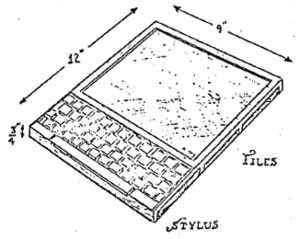Dynabook

The Dynabook's original illustration in Alan C. Kay's 1972 paper
|
|
| Developer | Alan Kay |
|---|---|
| Release date | Concept 1972 |
The KiddiComp concept, envisioned by Alan Kay in 1968, while a PhD candidate and later developed and described as the Dynabook in his 1972 proposal "A personal computer for children of all ages", outlines the requirements for a conceptual portable educational device that would offer similar functionality to that now supplied via a laptop computer or (in some of its other incarnations) a tablet or slate computer with the exception of the requirement for any Dynabook device offering near eternal battery life. Adults could also use a Dynabook, but the target audience was children.
Part of the motivation and funding for the Dynabook project came from the need for portable military maintenance, repair, and operations documentation. Eliminating the need to move large amounts of difficult-to-access paper in a dynamic military theatre provided significant US Department of Defense funding.
Though the hardware required to create a Dynabook is here today, Alan Kay still thinks the Dynabook hasn't been invented yet, because key software and educational curricula are missing. When Microsoft came up with its tablet PC, Kay was quoted as saying "Microsoft's Tablet PC, the first Dynabook-like computer good enough to criticize". A comment he had earlier applied to the Apple Macintosh.
Toshiba also has a line of sub-notebook computers called DynaBooks.
Describing the idea as “A Personal Computer For Children of All Ages.” Kay wanted the Dynabook concept to embody the learning theories of Jerome Bruner and some of what Seymour Papert— who had studied with developmental psychologist Jean Piaget and who was one of the inventors of the Logo programming language — was proposing. This concept was created two years before the founding of Xerox PARC. The ideas led to the development of the Xerox Alto prototype, which was originally called “the interim Dynabook”. It embodied all the elements of a graphical user interface, or GUI, as early as 1972. The software component of this research was Smalltalk, which went on to have a life of its own independent of the Dynabook concept.
...
Wikipedia
